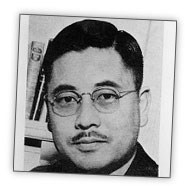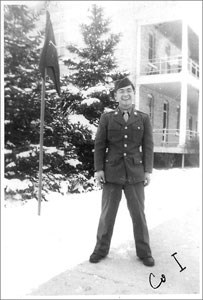
Knowledge of an enemy’s language and culture can shorten wars and facilitate the recovery. Based at Fort Snelling, Minnesota, from August 1944 to October 1946, the Military Intelligence Service Language School (MISLS) served the U.S. Army by providing this knowledge of the Japanese. Though far from the battlefields of World War II, Fort Snelling produced trained, educated, and battle-ready translators and code breakers for the war effort in the Pacific Theater. In the years leading up to World War II, two servicemen realized the need for the army to understand the Japanese language and culture. Capt. Kai E. Rasmussen had spent four years with the U.S. Army in Tokyo, Japan (1936-1940) and for six months observed the Japanese army during their war with China.Lt. Col. John Weckerling had studied Japanese in Japan in the 1920’s and returned to the U.S. as Assistant Military Attaché. As tensions rose between the U.S. and Japan, these two officers offered the War Department a blueprint for a military intelligence language school. Reluctantly, the War Department accepted the military intelligence school proposal and permitted them to establish the school as part of the Fourth Army, near its headquarters in San Francisco, California. Belatedly, the War Department funded the school, but with only $2,000. The school opened on November 1, 1941, in an old airplane hangar, receiving the appropriate title of the Fourth Army Intelligence School. 
Minnesota Historical Society A month later on December 7th, when the Japanese attacked Pearl Harbor, Hawaii, the school’s mission became much more urgent. However, as a result of the attack, Rasmussen and Weckerling had difficulty recruiting teachers for the school’s translators and interpreters. Rasmussen desperately needed a Director of Training, and he filled that position immediately after meeting John F. Aiso, a distinguished lawyer of Japanese descent who received his education at Harvard. When Rasmussen found Aiso, he was serving the U.S. Army as a mechanic in a truck repair outfit in Los Angeles, California. Three other instructors (Shigeya Kihara, Akira Oshida, and Tetsuo Imagawa) joined Aiso and provided the teaching base for the Fourth Army Intelligence School. The school’s initial function was teaching students Japanese reading, writing, interrogation, translation and interpretation. Students also studied captured documents; Japanese geography and map reading; Japanese military organization and technical terms; radio monitoring; and the social, political, economic and cultural background of Japan. Since the school only accepted Nisei (Japanese Americans) or non-Japanese Americans, it only admitted 60 students. Nisei represented the majority of proposed students, creating a tense situation for the school, since anti-Japanese sentiments escalated after the attack on Pearl Harbor. The Issei (Japanese aliens) and the Kibei (Japanese-Americans who studied in Japan for three or more years) were viewed by the U.S. government with mistrust, fearing that they might remain loyal to Japan and sabotage American efforts to fight the Japanese, leaving all hopes on the American born Nisei. Of all the students who were admitted to the school, only two were Caucasian. In February of 1942, Franklin D. Roosevelt signed the Executive Order 9066, which called for a military operation that directed the U.S. Army to remove 112,000 Japanese Americans from the West Coast and into internment camps (Manzanar). The school’s students reacted with animosity, fear, and apprehension. Since the majority of these camps existed in the West where the school was based, the schools staff found it apparent that the school needed a new base of operations. Looking back, John Aiso wrote: “There were a good many members of the general public in California at the time who were enormously antagonistic to all persons of Japanese ancestry, even those in the uniform of the United States Military Service. We in the school were of the opinion that we should move elsewhere in order to minimize any possible friction with these people, especially when our soldiers would be on the public streets during the weekends.” While Kai Rasmussen continued looking for much needed Japanese linguists, he also began a nationwide search to find a new home for the school. Rasmussen stated that he was looking for “a suitable location where a community would accept oriental-faced Americans for their true worth, American soldiers fighting with their brains for their native America.” After being denied by several Midwestern states, the Governor of Minnesota, Harold Stassen, accepted Rasmussen’s request. 
Rasmussen chose Camp Savage, located on the outskirts of southern Minneapolis, as the new site for the school. He selected this site for its proximity to an established army post (Fort Snelling) and two sizeable cities whose citizens would accept the Nisei with relatively little racial discrimination. In June of 1942 the school relocated with 18 instructors and 200 students. Graduates of the school were assigned to Army units in the Pacific Theatre and quickly proved their value in the field by giving American forces the much needed advantage of code breakers and negotiators. Subsequently, the War Department placed the school under its jurisdiction, expanded the school in terms of size, and renamed it the Military Intelligence Service Language School (MISLS). In August of 1944, the MISLS moved to Fort Snelling as class sizes exceeded the facilities at Camp Savage. Classes ran from 8:00 AM to 4:30 PM, and 7:00 PM to 9:00 PM, and students spent their free time studying combat intelligence and preparing for exams. Wednesday afternoons were reserved for military training and drills and Saturdays for examinations. Students' only leisure fell on Saturday afternoons and Sundays, when they would frequent the Mun Hing Cafeteria on Hennepin Avenue in Minneapolis, or enjoy Minnesota pastimes such as fishing and skiiing. They also competed in sports like volleyball, contributed to the Fort Snelling Bulletin and published their own newsletter for alumni in the field. By the time the school had found its way to the fort, it had produced 1600 graduates, 142 officer candidates and 53 officers. When the facility closed in 1946, over 6,000 students had graduated. As the war ended, the school's curriculum changed to focus on other Asian countries that the U.S. would potentially be dealing with in the future. The school offered Chinese and Korean classes, and the focus grew to include civil affairs and government to help with the occupation of Japan. Three months later, the Women's Army Corps made their debut at the school, ready to acquire an education that would prepare them for their time in Japan. After their training, the Corps sent many women to Tokyo to become a part of the U.S. Federal Civil Service during the occupation. In June of 1946 the school moved from Fort Snelling to Monterey, California, and was renamed the U.S. Army Language School. The MISLS graduates had a significant influence on the war in the Pacific Theater by giving the Army the knowledge needed to help defeat the Japanese. General Douglas MacArthur's Chief of Staff for Military Intelligence, Major General Charles Willoughby said, "The Nisei shortened the Pacific War by two years and saved possibly a million American lives and saved probably billions of dollars." The final reorganization of the school took place in July of 1963 when the War Department renamed it the Defense Language Institute (DLI). Today, many consider the DLI to be one of the world's premier language schools. From its roots in California and Fort Snelling in Minnesota, the MISLS served as a testament to the commitment and loyalty of the Japanese-American community in the U.S. The schools effectiveness was profound and the students and their stories serve as a guide by which we can better comprehend the true importance of understanding an enemy's language and culture. |
Last updated: November 22, 2019
